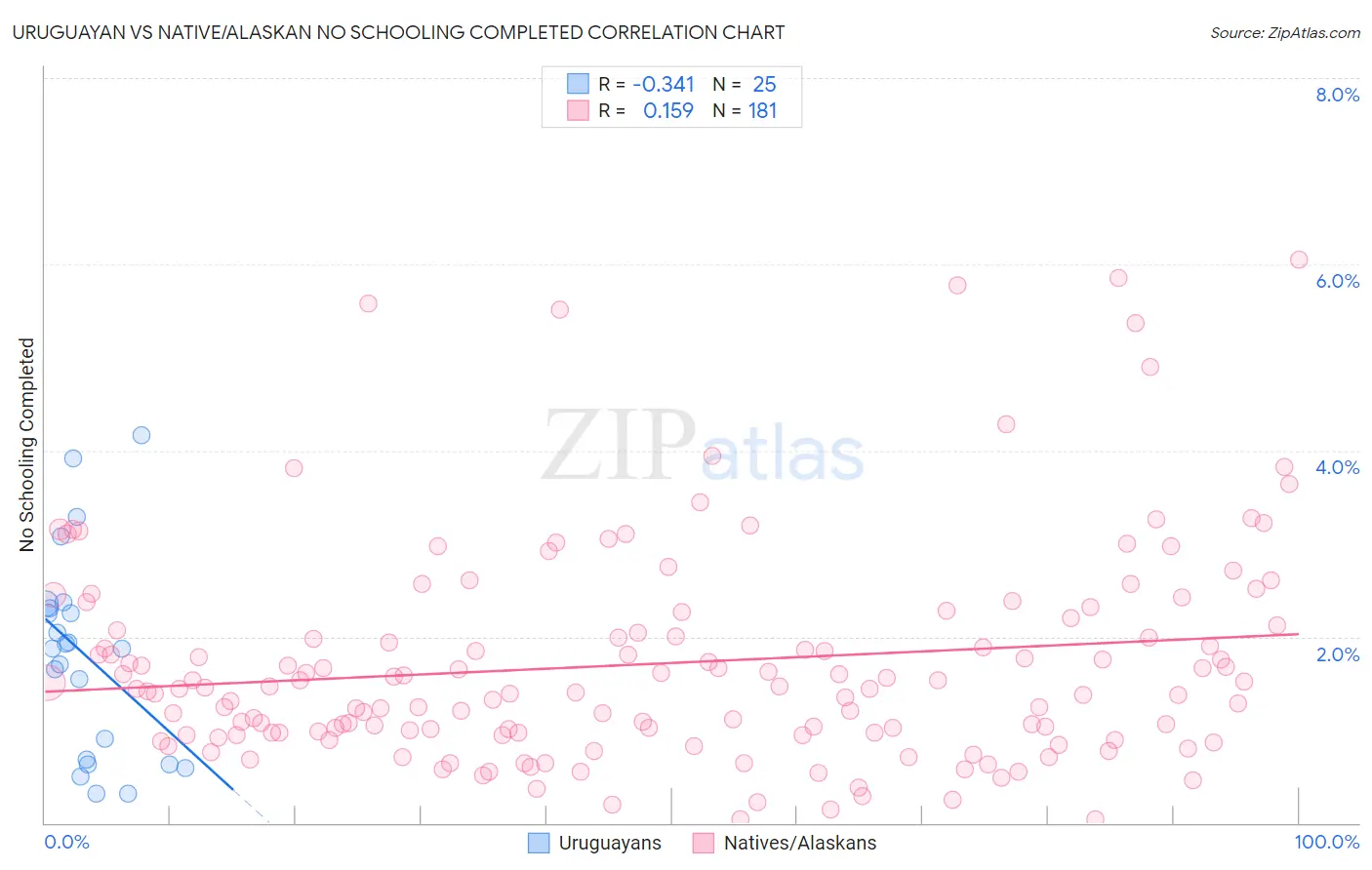Uruguayan vs Native/Alaskan No Schooling Completed
COMPARE
Uruguayan
Native/Alaskan
No Schooling Completed
No Schooling Completed Comparison
Uruguayans
Natives/Alaskans
2.2%
NO SCHOOLING COMPLETED
11.0/ 100
METRIC RATING
208th/ 347
METRIC RANK
2.2%
NO SCHOOLING COMPLETED
10.0/ 100
METRIC RATING
210th/ 347
METRIC RANK
Uruguayan vs Native/Alaskan No Schooling Completed Correlation Chart
The statistical analysis conducted on geographies consisting of 144,399,901 people shows a mild negative correlation between the proportion of Uruguayans and percentage of population with no schooling in the United States with a correlation coefficient (R) of -0.341 and weighted average of 2.2%. Similarly, the statistical analysis conducted on geographies consisting of 503,675,211 people shows a poor positive correlation between the proportion of Natives/Alaskans and percentage of population with no schooling in the United States with a correlation coefficient (R) of 0.159 and weighted average of 2.2%, a difference of 0.33%.

No Schooling Completed Correlation Summary
| Measurement | Uruguayan | Native/Alaskan |
| Minimum | 0.31% | 0.041% |
| Maximum | 4.2% | 6.0% |
| Range | 3.9% | 6.0% |
| Mean | 1.8% | 1.7% |
| Median | 1.9% | 1.4% |
| Interquartile 25% (IQ1) | 0.65% | 0.96% |
| Interquartile 75% (IQ3) | 2.3% | 2.1% |
| Interquartile Range (IQR) | 1.7% | 1.1% |
| Standard Deviation (Sample) | 1.1% | 1.2% |
| Standard Deviation (Population) | 1.1% | 1.2% |
Demographics Similar to Uruguayans and Natives/Alaskans by No Schooling Completed
In terms of no schooling completed, the demographic groups most similar to Uruguayans are South American Indian (2.2%, a difference of 0.0%), Immigrants from Bahamas (2.2%, a difference of 0.19%), Bahamian (2.2%, a difference of 0.19%), Immigrants from Oceania (2.2%, a difference of 0.25%), and Hopi (2.2%, a difference of 0.59%). Similarly, the demographic groups most similar to Natives/Alaskans are Immigrants from Oceania (2.2%, a difference of 0.070%), South American Indian (2.2%, a difference of 0.33%), Immigrants from Panama (2.3%, a difference of 0.45%), Immigrants from Morocco (2.3%, a difference of 0.46%), and Immigrants from Bahamas (2.2%, a difference of 0.52%).
| Demographics | Rating | Rank | No Schooling Completed |
| Africans | 21.8 /100 | #199 | Fair 2.2% |
| Immigrants | Northern Africa | 19.5 /100 | #200 | Poor 2.2% |
| Costa Ricans | 17.1 /100 | #201 | Poor 2.2% |
| Moroccans | 13.7 /100 | #202 | Poor 2.2% |
| Laotians | 13.3 /100 | #203 | Poor 2.2% |
| Hopi | 12.9 /100 | #204 | Poor 2.2% |
| Immigrants | Bahamas | 11.6 /100 | #205 | Poor 2.2% |
| Bahamians | 11.6 /100 | #206 | Poor 2.2% |
| South American Indians | 11.0 /100 | #207 | Poor 2.2% |
| Uruguayans | 11.0 /100 | #208 | Poor 2.2% |
| Immigrants | Oceania | 10.2 /100 | #209 | Poor 2.2% |
| Natives/Alaskans | 10.0 /100 | #210 | Tragic 2.2% |
| Immigrants | Panama | 8.8 /100 | #211 | Tragic 2.3% |
| Immigrants | Morocco | 8.7 /100 | #212 | Tragic 2.3% |
| Ute | 8.2 /100 | #213 | Tragic 2.3% |
| Samoans | 8.2 /100 | #214 | Tragic 2.3% |
| Immigrants | Zaire | 7.2 /100 | #215 | Tragic 2.3% |
| Tongans | 6.8 /100 | #216 | Tragic 2.3% |
| Immigrants | Syria | 6.6 /100 | #217 | Tragic 2.3% |
| Immigrants | Nepal | 6.4 /100 | #218 | Tragic 2.3% |
| Senegalese | 5.6 /100 | #219 | Tragic 2.3% |